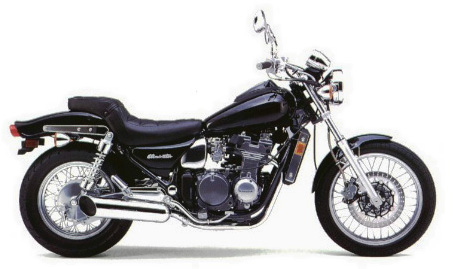| 1986–87 & 1996–97 Kawasaki ZL600 Eliminator |
|---|
| Performance |      |
|---|
| The 600 Eliminator is a perfect case study of how our perceptions of performance change over time. When the ZL600A first appeared in 1986, it shared its engine with the original 600 Ninja, which had been introduced as a hardcore, class-leading middleweight sportbike only a year earlier. The engine was re-tuned for cruiser duty through revised carburation and exhaust that favored low-end grunt, but reduced peak power slightly to around 65–70 horsepower. Zero-60 time was under 4 seconds, top speed could tickle 120 MPH, and it was viewed as a fun, fast, capable machine. When the Eliminator was re-introduced to the US market a decade later as the ZL600B, it was criticized for being way too slow and gutless. The amazing thing is, the performance of the A and B models was identical; what had changed was the marketplace, and our perception of what was fast and what was slow. Personally, I still find the ZL600 more than capable, even if I wouldn't go jonesin' for stop-light drag race on one. |
|
| Handling |      |
|---|
| It won't corner like a sportbike, but it isn't one. The Eliminator has adequate ground clearance, and the steering strikes a nice balance between maneuverability and highway stability. The brakes are a bit wimpy. |
|
| Looks |      |
|---|
| I really like the 600 Eliminator's look; it is cleaner and less gimmicky than than the original 900, but doesn't lose the aggressive stance. The '90s version's wire wheels change the overall look remarkably, compared to original A-model's cast wheels. Those 3-spokes screamed 'muscle bike' and look slightly dated now; the more classic wire spokes of the B-model impart a cruiser vibe that's more in keeping with the ZL's character. |
|
| Reliability |      |
|---|
| Despite eventually being slotted as a beginner bike, the 600 Eliminator was not originally designed as a bargain-basement offering; its price and construction reflected that. The motor was reliable in the Ninja despite high-revving racing use. Even though the Eliminator's conversion to shaft drive lowered the final drive ratio, the drivetrain should endure cruiser-level use for quite a long time. |
|
| Practicality |      |
|---|
| The Eliminator wasn't perfect, but it does live up to its do-everything objective pretty well. The seat and the riding postion are reasonably comfy. The only drawbacks are the drastically stepped seat, which creates a somewhat cramped cockpit for riders over about five-ten, and a disappointing 100 MPH fuel range. There are still a good number of B-models out there in good shape. |
|
| Desirability |      |
|---|
| There are a lot of bikes on the market that are more capable or exotic, but lack the ZL600's style and flexibility. |


